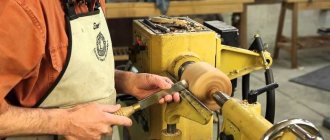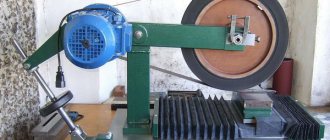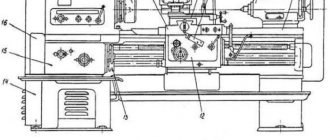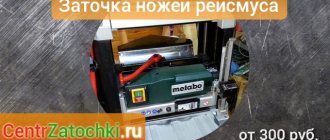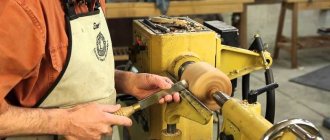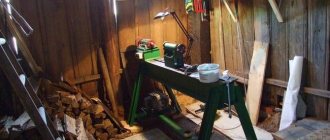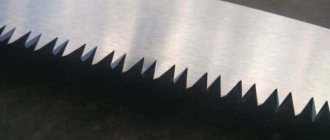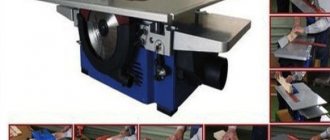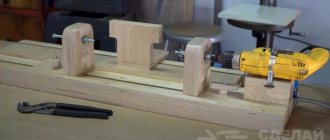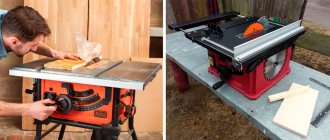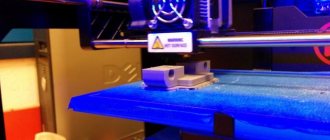When processing an edged board, the jointer is in the initial stage of creating a basic, flat surface. The plane is formed on one or two sides of the workpiece located at right angles. The wooden element, having passed this preparatory planing stage, becomes suitable for subsequent processing using thicknessing devices.
Planer and its purpose
When considering what a jointer is, we note that this tool is used to change the quality of the surface of wood. It largely determines how pleasant the final product will be. The jointer can look very different; the mechanical version is represented by a combination of three main elements:
- Cases.
- Pens.
- Knife.
In most cases, the body is made using wood, but there are also metal versions. A product with a wooden body is suitable for working with soft wood, while metal is designed to withstand heavy loads. When considering why a jointer is needed, we note the following points:
- It is used when it is necessary to align large fragments. In this case, the workpiece can have a large area and length.
- The installed cutters can be up to 8 cm wide, while the block is also characterized by quite large dimensions.
- The first use of the tool causes the formation of small chips, the second time causes the formation of long, uniform chips.
- There are a variety of types of tools on sale; the choice is made depending on the task at hand.
The manual version differs from the electric one, which has a complex design. It consists of the following:
- A thrust handle through which force is transmitted.
- Socket for connecting a vacuum cleaner. It is worth considering that at the time of work a large amount of chips may form. To ensure that it does not have a negative impact on the work being carried out, a special vacuum cleaner is connected, which immediately after the appearance of chips collects it.
- Control buttons allow you to set basic device parameters.
- Manual screw is found on almost all devices. It is required to change the planing depth.
- There is also a side stop, due to which the working width of the surface being treated is changed.
- Protective hinged cover that eliminates the possibility of damage.
- Sole. It comes into contact with the surface being treated and is often represented by aluminum.
- Many devices are characterized by having a built-in battery. In addition, there is also the possibility of connecting a cable.
Electrical equipment must be properly maintained. Long-term use requires sharpening.
Advantages and disadvantages
The advantages of planing machines include:
- simplicity of design;
- the ability to quickly and efficiently level the surface, eliminate all defects, make the workpiece clean and smooth;
- processing of parts with a thickness of 5 mm or more is allowed;
- it is possible to adjust the stop that changes the inclination of the edge relative to the plane;
- high productivity with constant surface quality.
There are also disadvantages:
- work on jointing machines is one of the most dangerous, requiring strict adherence to safety rules;
- Setting up knives requires care and attention. Inexperienced craftsmen often make a lot of mistakes, they do not tighten the wedge stops, causing the knives to fly out of the socket;
- sharpening knives requires special devices or full-fledged machines;
- The quality of the plane and the straightness of the edge depend on the settings of the tables.
Setting up a jointer is a challenging task. Experienced adjusters are highly valued in machine tool circles; they are invited to adjust equipment and are asked to provide consultations.
Types of tools
The classification is very extensive and is associated with various properties. There are two main types:
- A hand jointer can be found in almost any workshop. Its peculiarity lies in the prostate of the device, as well as its low cost.
- Recently, an electric jointer has often been purchased. This is due to ease of operation, as well as fairly high efficiency in use. The only drawback is the fairly high cost.
The materials used in the manufacture of the main part may differ significantly. Wooden tools are more common, as they are simple and much cheaper. It is suitable for a home workshop. There are also metal structures designed to work in extremely difficult conditions.
The classification is carried out according to what the task is. Examples include the following devices:
- For working with wooden workpieces that have not been processed in any way before. This variety is called Sherhebel. In most cases, a metal is used that can withstand significant impact.
- If finished parts need to be glued together after processing, then tsinubel is used. This design option is characterized by the fact that the knife has serrations. After planing, small grooves appear on the surface. As practice shows, such a surface is best suited for gluing.
If the resulting products do not need to be glued together in the future, you can use a double or single jointer. The main types of carpentry tools include the following:
- The grinder is represented by a type of design, which is characterized by a shortened body and an increased rake angle, as well as a reduced slot for removing chips. The scope of application is to align the ends and remove various burrs.
- In some cases, a semi-joint is used. It is characterized by a reduced length, but the required width remains. Used when working with large parts.
- The folding belt is used for sampling and quartering. It has a design that has a removable sole. The tool differs from others in width and is a specific design option.
- Zenzubel has a double-sided knife made using high-quality steel. The width of this element is 33 mm.
Mini jointers are also available for sale. It is often used in domestic settings, as it is small in size and has sufficient performance. In addition, all devices can be divided into two main groups:
- Household is characterized by low cost, as well as reduced performance characteristics. It is widespread because it costs less.
- A professional jointer is used for work in industry. Its main qualities include increased productivity, as well as the ability to work for a long period.
The production of the instrument in question is carried out by a variety of companies. There is also an industrial jointer that can be used for a long period.
Advantages
The main task of the jointer is to prepare the wooden workpiece so that it can be processed even more precisely in the future. Equipment advantages:
- The device allows you to perform many different operations.
- Large beams can be processed.
- It is good to plan furniture parts, for example, legs for tables and chairs.
- Plans the part in a curvilinear manner: along a plane or along an edge.
- If products need to be chamfered at an angle, then this equipment is also used.
- They have an affordable price.
You need to know that it is impossible to plan thickness to size using an industrial or household jointer. The device is also not designed for processing parallel surfaces.
Electric
Today, a stationary jointer can be manufactured in an electric version. Professional devices are characterized by the following features:
- Quite a large mass and clamping force.
- During operation, high precision can be achieved.
- Increased labor productivity.
- Often the design provides the ability to quickly change knives.
The electric jointer is used in industry and everyday life; the product is characterized by high performance characteristics. The only drawback in most cases is the high cost, as well as significant energy consumption.
Kraton WMT 318 – 26500₽
A simple and popular thicknessing machine Cardboard WMT 318 is assembled on a rigid frame frame. Which, given its relatively modest size and not very heavy weight, is a significant factor. Determining the accuracy and reliability of equipment for a small workshop. They also purchase this model for work on the road.
Starting is carried out using a key located under the protective cap. Nearby there is a button to activate the thermostatic unit. The movable planing block located above the work table moves (in the vertical plane). Precise control is provided by the handle located on top.
One of the key features that distinguishes this model is dynamic braking - a process that reduces the “free run” time (rotation by inertia) of the engine.
Folding extensions and automatic feeding of the workpiece under the planing shaft greatly simplify the work with long lumber. Main technical characteristics of Kraton WMT 318
| Characteristics | Values |
| power, kWt | 1.5 |
| Shaft rotation speed, rpm | 8 |
| Automatic feed speed of workpiece, m/min | 8 |
| Planing depth (maximum / working), mm | 3 / 1.5 |
| Limit dimensions of the workpiece (H-height / B-width), mm | H-5-153, B-318 |
| Thicknessing table length, mm | 580 |
| Design features | Folding sections of the work table, a cap to prevent accidental start-up, dynamic braking, cross shafts at the ends of the table and the top of the body |
| Add. equipment | |
| Weight, kg | 31 |
| Development/production | Russia / Russia, Southeast Asian countries |
| Cost, rub. | 26500 |
Watch a short video review of the device and capabilities of the Kraton WMT 318 machine:
Planer or planer
A fairly common question is what is the difference between a planer and a jointer. Both options allow material to be removed from the surface. The difference is this:
- The plane is intended for primary work. As a rule, the layer of material for which the equipment is configured is removed from the surface. Planing is carried out to remove knots and bumps. The design is represented by a combination of a knife and a block; in some cases, two cutting elements are installed.
- The jointer is considered a type of the first tool; it is a long version of the body, due to which the device is pressed with great force onto the surface being processed. In this case, 2 blades are also installed, which provide a finishing jointer.
Both options are found in the standard kit of a professional who processes wood.
Special SRM-2000 – 20990₽
The frame structure of the SRM-2000 body, assembled on a cast base, provides the machine with sufficient rigidity. Which is useful for effective calibration of timber, edged and unedged boards, up to 330 mm wide. The height of the workpiece can be in the range of 6-160 mm. The minimum length of lumber is limited by the distance between the edges of the rubberized rollers. The maximum indicator is not limited in any way. That is, this equipment is able to satisfy any user needs in the construction, repair and finishing of residential and auxiliary premises.
The transmission of torque to the working shaft from a powerful commutator motor is carried out via a belt drive.
Due to this, the noise level and the likelihood of damage to the power unit are reduced when the load increases beyond the calculated values. Auxiliary rollers on the edges of the table enlargers and the upper surface of the machine simplify working with long lengths. Automatic overload protection and a block that prevents the equipment from turning on after a drop in mains voltage are responsible for operational safety. Main technical characteristics of Spets SRM-2000
| Characteristics | Values |
| power, kWt | 2.0 |
| Shaft rotation speed, rpm | 8000 |
| Automatic feed speed of workpiece, m/min | 8 |
| Planing depth (maximum / working), mm | 3 / 1.5 |
| Limit dimensions of the workpiece (H-height / B-width), mm | H-6-160/B-330 |
| Thicknessing table length, mm | 350 |
| Design features | Steel frame on a cast base, planing depth adjustment knob, auxiliary rollers to facilitate workpiece feeding |
| Add. equipment | Exhaust pipe, knife installation template, installation tools |
| Weight, kg | 31 |
| Development/production | Russia / China |
| Cost, rub. | 20990 |
Watch video review of Special SRM 2000:
Difference from surface planer
Also, many consider what is the difference from a surface planer. When considering a thicknesser and a jointer, it should be borne in mind that the first option is intended for drawing parallel lines on the surface. Both options can process wood; among the features, the following points should be taken into account:
- Flat surfaces can be obtained with a thicknesser, but the equipment is designed for finishing.
- Both tools work exclusively in conjunction. The jointer is intended for preparation, second final processing.
In general, we can say that there are quite a lot of differences. In this case, the structural elements differ insignificantly, but the thicknesser allows you to reduce the degree of roughness of the surface layer.
Safety regulations
Working on a jointer belongs to the highest category of danger and requires strict adherence to safety rules. There are many of them, let’s consider only the most basic ones:
while planing, do not hold your hands over the rotating knife shaft;- the sleeves of the work jacket should be buttoned, there should be no hanging ends;
- during work you must use a special pusher for workpieces;
- start work only after the blade shaft rotation speed has fully reached;
- the workpiece must be carried out smoothly, without jerking;
- Normal lighting of the machine is necessary, but the working area cannot be illuminated with fluorescent lamps (due to flickering).
Expert opinion
Levin Dmitry Konstantinovich
The full list of safety requirements is much broader and should be carefully studied before starting work.
How to joint boards correctly
The wood cutting machine used is characterized by its specific properties. Jointing is a process of processing the surface of wood of varying densities. The recommendations are as follows:
- Take the handle with your left hand, and the block with your right.
- The tool is guided along the fibers.
- As the product is ready, the chips become long and even throughout their thickness.
When working, do not handle the blade; you should wear protective clothing while working. At the time of work, the boards must be securely fastened.
Planer-thicknesser machine
There is also a planer-thicknesser machine, which provides high-quality processing. The advantage of the device is its increased functionality.
In most cases, the device is installed in industry. This is due to the fact that it is quite expensive and can significantly increase labor productivity.
High-quality processing is guaranteed, but the equipment must be used correctly.
Design Features
Planing and thicknessing machines are designed for beautiful and high-quality processing of the front part of wood. All defects and irregularities are removed, giving the product a beautiful appearance. The devices are used both in home workshops and in large-scale production, where these operations must be performed daily.
After processing, the result is a smooth and clean workpiece that preserves the texture of the wood. Some models are capable of not only performing this process, but also chamfering. It should be remembered that it is important to completely dry the wood before starting work. This is the only way the operation will be completed without problems.
Features of operation and device
The equipment in question is characterized by certain application features. Among the features we note the following:
- The bottom surface must be level. This can be achieved by pre-jointing.
- Simultaneous processing is only possible when using a machine that has the appropriate properties.
- The machine is ideal for working with previously unprepared workpieces.
- The device is designed as a combination of several parts, all of which are responsible for specific functions.
In general, we can say that such a machine is characterized by high functionality. The design of a jointer of this type may differ significantly.
Popular manufacturers and cost
Modern companies offer many samples of the equipment in question, differing in their configuration, price and quality. However, even with fairly modest financial resources, it is possible to select and purchase a decent machine for work purposes. And even foreign manufacturers offer affordable prices in this regard. “GriGGIO” can also be classified as such. At the same time, domestic manufacturers will be able to provide tools that have excellent price/quality ratios. Among these, we can note the products of the Kuibyshev Machine Tool Plant.
The cost of professional models for industry is very high. The price here will first of all depend on the configuration, and then on the manufacturer. A standard industrial machine will cost approximately 150,000 - 200,000 rubles. Home equipment is much cheaper, but it is less functional. The price of household tools ranges from 15,000 to 20,000 rubles. At the same time, according to user reviews, the first place in the Russian Federation today in terms of functionality and performance is occupied by the SF-400A model from JSC KSZ - the machine is considered semi-professional and costs about 100,000 rubles.
Recommendations when choosing equipment
When choosing which machine to choose is a very common question, you need to pay attention to several main points. They are as follows:
- Number of knives on the working part.
- Power of the installed engine.
- Dimensions and weight of equipment.
- The speed of movement of the workpiece at the time of processing.
All parameters should be taken into account when considering the most suitable design option.
Interskol RS 330 1500 – 25400₽
Interskol RS is one of the few successful low-cost developments.
It stands out not only for its reasonable cost, but also for its impressive operating potential (the thermal protection relay is responsible for the duration of operation of the commutator motor). The security system is also at the proper level (the power button is hidden under a folding cover, the power button is duplicated by a wide “fungus” located behind the protective cover). The budget model is intended for personal use only. And in the absence of excessive load (the source of which may be material with natural moisture), it will please the owner. It has a low (for a chain drive of shafts) noise level. Automatic broaching allows you to count on a decent result for thicknessing wood of any species.
The high-quality level of processing is achieved not only due to the high speed of the planing shaft with two carbide knives.
The organization of chip removal from the workspace is also important. Why the machine includes a plastic catcher body and an adapter for connecting a vacuum cleaner. Main technical characteristics of Interskol RS 330 1500
| Characteristics | Values |
| power, kWt | 1.5 |
| Shaft rotation speed, rpm | 9000 |
| Automatic feed speed of workpiece, m/min | 7 |
| Planing depth (maximum / working), mm | 2.8 / 0.8 |
| Limit dimensions of the workpiece (H-height / B-width), mm | H-13-152/B-19-330 |
| Thicknessing table length, mm | 350 |
| Design features | Automatic feed with chain reducer, thermal protection relay, upper passive rollers for moving long items |
| Add. equipment | Template for installing knives, chip guard, set of necessary keys |
| Weight, kg | 33 |
| Development/production | Russia / China |
| Cost, rub. | 25400 |
Watch a short video review revealing the working potential of the Interskol RS 330 1500 machine:
Types of machines
There are quite a large number of different machines that can be used for working with wood. The asynchronous motor is protected by a special casing. Equipment with simultaneous planing and thicknessing functions has several advantages:
- The switch is made in the form of a rotary block.
- In most cases, the frame is made with powder paint, which significantly increases the protection of the surface from environmental influences.
- Submission of material can be carried out at any time.
- Provides protection from environmental influences.
- Some models come with two blades.
In most cases, classification is carried out according to engine power, functionality and some other characteristics. In addition, the popularity of the brand is important.
Criterias of choice
The selection of a machine is made according to several criteria:
- dimensions;
- planing width;
- rotation frequency;
- price.
The size of the machine must correspond to the size of the workshop, taking into account the length of the workpieces on both sides of the working base. Planing width is important for furniture makers. The rotation speed ensures clean processing. It is also important to take into account the speed of rotation of the shaft and the number of knives - the more there are, the more difficult it is to adjust the height, and the more difficult it is to sharpen.
New segmented shafts require sharpening less often, but there are still few specialists working with them. If you select a machine with such a shaft, you must carefully study the instructions for replacing and sharpening cutting edges. It must be borne in mind that a spiral shaft is much more expensive than a conventional blade shaft, which will significantly increase the price of the machine.
A jointing machine is a necessary element of workshop equipment. Its design is relatively simple, but it should not be taken too lightly. Any error during adjustment leads to the appearance of processing defects, violations of the plane or straightness of the edges. In addition, jointing machines require caution, compliance with safety rules, and ensuring normal working conditions. Then the results of processing workpieces will be of consistently high quality.
Sharpening jointer knives
Do not forget that knives should be sharpened periodically. Even when using high-quality steel, there is a possibility of damage to the cutting edge. The features of the process include the following:
- Requires special equipment.
- You need to maintain a certain angle.
- Even minor defects can cause a serious reduction in efficiency.
You can sharpen the jointer knives yourself, but this requires certain equipment.
Equipment setup
This process should begin with checking the quality of sharpening of knives - their blades should have an extreme bevel of 40 degrees, and the radius of the rounding edge should not exceed more than 8 millimeters.
After checking the sharpness, the knives must be secured to the planing shaft. Before this, you need to lower the back and front tiles. When installing the cutting elements, it is necessary to check the parallelism of the blades - this factor should not be more than 0.1 mm per meter. To make adjustments easier, you can use a special indicator device.
After installing the knives, you need to check:
- The protrusion beyond the edge of the overlays should not be more than 2 mm;
- The protrusion beyond the edge of the planing shaft should not be more than 22 mm.
Then you need to set the height of the desktop. The distance between the lips of the tiles and the cutting edge must be within 3mm, otherwise unplanned depressions may form on the workpiece during work.
The next step is to determine the location of the guide. The distance between the left edge and the ruler of the knife shaft should always be greater than the width of the wooden block. The guide is determined by the template and fixed with screws.
The final stage will be a performance test through a trial run of the machine. The launch should not be accompanied by any malfunctions or visual deviations from the norm, and then work processes can continue on it. Otherwise, the setup should be repeated and, if problems are identified again, repairs should be made or faulty parts should be replaced.
Safety precautions when using a jointer
Considering the design, it allows processing in a wide variety of conditions. The main recommendations are as follows:
- Protective clothing and goggles must be used.
- Do not touch the blades or place your hands in the cutting area.
- The workpiece must be securely fastened.
In general, we can say that the jointer is a common tool that is found in almost every workshop today. You can choose the right one solely based on what work will be done in the future.
